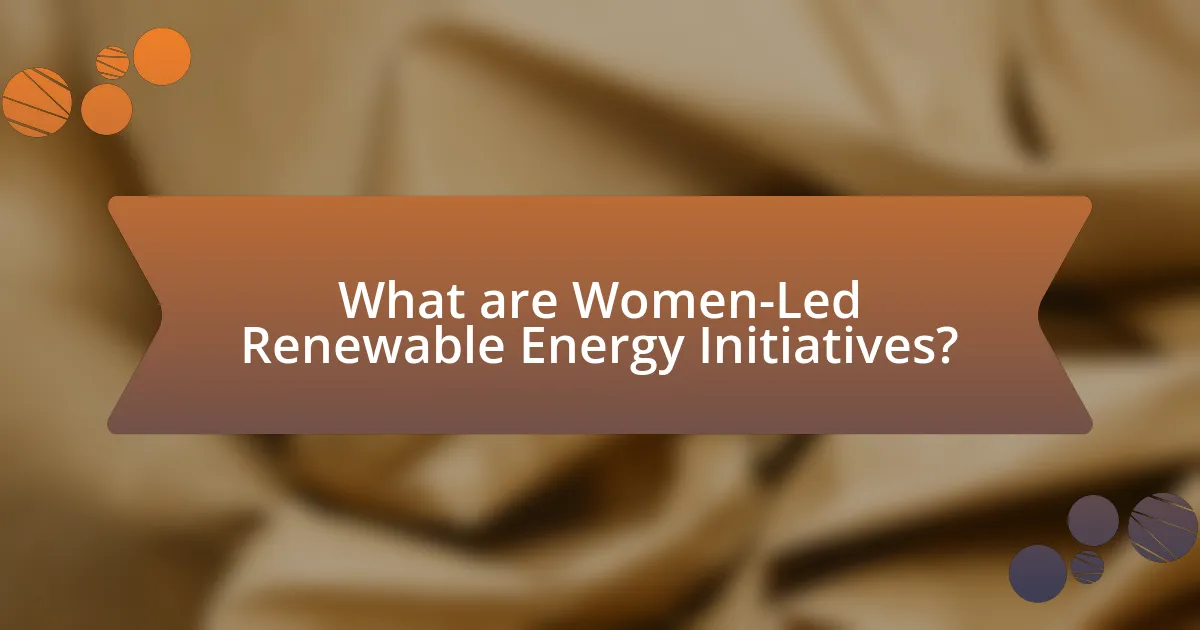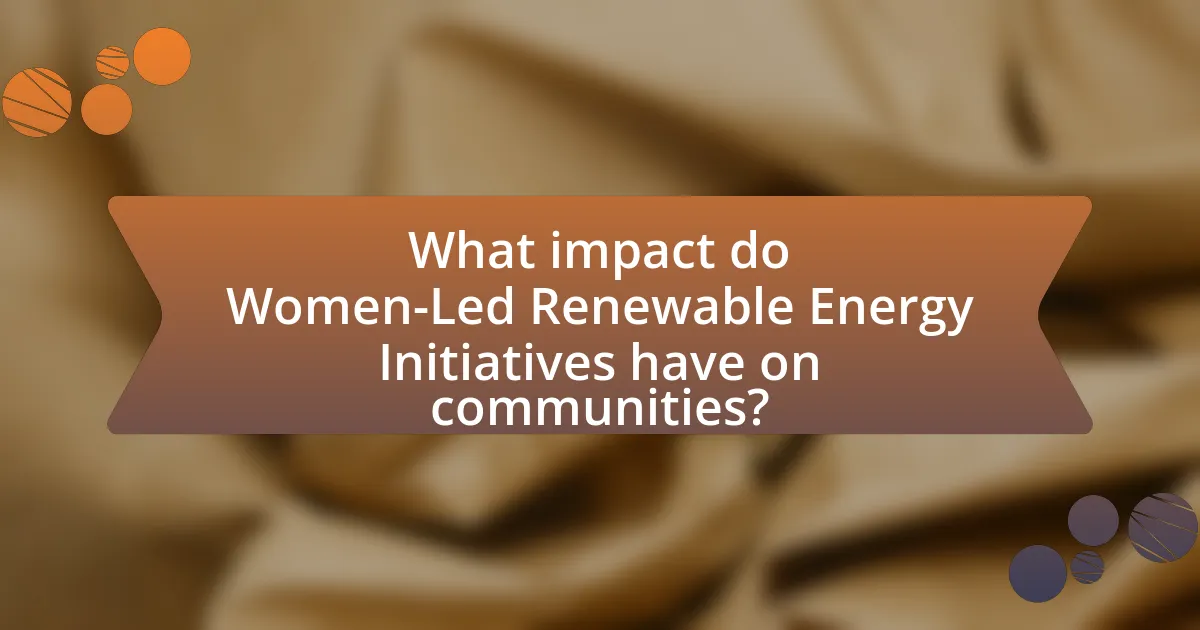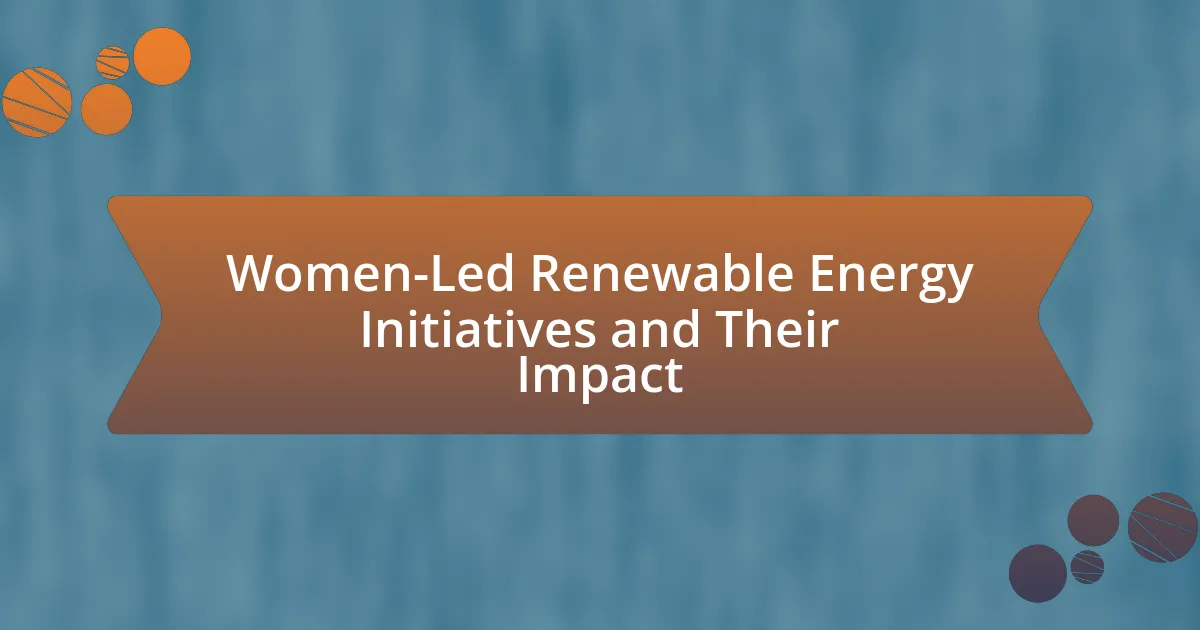Women-led renewable energy initiatives are projects and organizations primarily directed by women, focusing on the development and promotion of sustainable energy solutions. These initiatives aim to empower women, enhance community resilience, and address climate change by prioritizing local needs and social equity. The article explores the unique challenges women face in the renewable energy sector, the objectives of these initiatives, and their alignment with global sustainability goals. It also highlights the impact of women-led projects on communities, local economic development, and environmental benefits, while providing examples of successful initiatives and best practices for replication.

What are Women-Led Renewable Energy Initiatives?
Women-led renewable energy initiatives are projects and organizations primarily directed by women that focus on the development, implementation, and promotion of renewable energy solutions. These initiatives often aim to empower women in energy sectors, enhance community resilience, and address climate change through sustainable practices. For instance, the Global Women’s Network for the Energy Transition highlights the role of women in advancing clean energy technologies and policies, demonstrating that women-led efforts can lead to increased innovation and improved energy access in underserved communities.
How do these initiatives differ from traditional energy projects?
Women-led renewable energy initiatives differ from traditional energy projects primarily in their focus on community engagement and social equity. These initiatives often prioritize local needs and involve women in decision-making processes, which enhances the inclusivity and sustainability of energy solutions. For instance, research indicates that women-led projects tend to allocate resources more effectively to address the specific energy needs of underserved communities, resulting in improved access to clean energy. This contrasts with traditional energy projects, which frequently emphasize profit maximization and may overlook the social implications of energy access.
What unique challenges do women face in the renewable energy sector?
Women in the renewable energy sector face unique challenges such as gender bias, lack of representation, and limited access to funding. Gender bias manifests in workplace cultures that often favor male leadership, leading to fewer opportunities for women to advance. According to a report by the International Renewable Energy Agency (IRENA), women hold only 32% of the global renewable energy workforce, highlighting the significant underrepresentation. Additionally, women entrepreneurs in this sector often struggle to secure financing; a study by the Global Women’s Network for the Energy Transition found that women-led projects receive only 1% of total energy investment. These challenges hinder women’s participation and leadership in renewable energy initiatives, impacting overall sector growth and innovation.
How do women-led initiatives address these challenges?
Women-led initiatives address challenges in renewable energy by promoting inclusive decision-making and leveraging local knowledge. These initiatives often focus on community engagement, ensuring that women’s perspectives and needs are integrated into energy projects. For example, studies show that women-led renewable energy projects can increase access to clean energy in underserved areas, as they prioritize sustainable practices and community benefits. Additionally, women leaders in these initiatives often advocate for policies that support gender equality in energy access, which can lead to improved economic outcomes and enhanced energy security for communities.
What are the key objectives of women-led renewable energy initiatives?
The key objectives of women-led renewable energy initiatives include promoting gender equality, enhancing community resilience, and increasing access to sustainable energy. These initiatives aim to empower women by providing leadership roles in energy projects, which can lead to improved decision-making and resource management. Research indicates that when women are involved in renewable energy projects, there is often a greater focus on community needs and sustainable practices, resulting in more effective energy solutions. For instance, the International Renewable Energy Agency reported that gender-inclusive policies can boost economic growth and energy access, highlighting the importance of women’s participation in the renewable energy sector.
How do these objectives align with global sustainability goals?
Women-led renewable energy initiatives align with global sustainability goals by promoting gender equality and advancing clean energy solutions. These initiatives contribute to Sustainable Development Goal 5 (Gender Equality) by empowering women in leadership roles within the energy sector, thereby enhancing their economic opportunities and decision-making power. Additionally, they support Sustainable Development Goal 7 (Affordable and Clean Energy) by increasing access to renewable energy sources, which is essential for reducing carbon emissions and combating climate change. Evidence shows that when women are involved in energy projects, there is often a greater focus on community needs and sustainable practices, leading to more effective and inclusive energy solutions.
What role do women play in decision-making processes within these initiatives?
Women play a crucial role in decision-making processes within women-led renewable energy initiatives by actively participating in leadership positions and influencing project outcomes. Research indicates that when women are involved in decision-making, projects tend to be more inclusive and sustainable, as they bring diverse perspectives and priorities that address community needs. For instance, a study by the International Renewable Energy Agency (IRENA) found that gender-diverse teams are more effective in problem-solving and innovation, leading to better project performance and community acceptance. This evidence underscores the importance of women’s involvement in shaping energy policies and initiatives, ultimately enhancing the effectiveness and reach of renewable energy projects.

What impact do Women-Led Renewable Energy Initiatives have on communities?
Women-led renewable energy initiatives significantly enhance community resilience and economic empowerment. These initiatives often prioritize local needs, leading to increased access to clean energy, which can improve health outcomes and reduce energy costs for households. For instance, a study by the International Renewable Energy Agency found that women-led projects are more likely to involve community engagement and capacity building, resulting in sustainable energy solutions that benefit the entire community. Additionally, women’s leadership in these initiatives fosters gender equality and encourages the participation of other marginalized groups, further strengthening community cohesion and development.
How do these initiatives contribute to local economic development?
Women-led renewable energy initiatives contribute to local economic development by creating jobs, fostering entrepreneurship, and enhancing energy access. These initiatives often employ local community members, thereby reducing unemployment rates and increasing household incomes. For instance, a study by the International Renewable Energy Agency found that renewable energy sectors can create up to 24 million jobs globally by 2030, with women playing a crucial role in this workforce. Additionally, these initiatives promote local businesses by providing opportunities for women entrepreneurs to engage in energy-related ventures, which stimulates local economies. Furthermore, improved energy access from these projects can lead to increased productivity in local industries, further driving economic growth.
What specific job opportunities arise from women-led renewable energy projects?
Women-led renewable energy projects create specific job opportunities in various sectors, including project management, engineering, and community outreach. These initiatives often require skilled professionals to oversee the development and implementation of renewable energy systems, such as solar and wind farms. For instance, a report by the International Renewable Energy Agency (IRENA) highlights that women-led projects can increase employment in technical roles, as they often prioritize hiring local women, thus fostering economic empowerment. Additionally, roles in policy advocacy and education emerge, as women leaders frequently engage in promoting sustainable practices and raising awareness about renewable energy benefits within their communities.
How do these initiatives empower women in their communities?
Women-led renewable energy initiatives empower women in their communities by providing them with leadership roles, economic opportunities, and access to sustainable resources. These initiatives often involve women in decision-making processes, enabling them to influence energy policies and practices that directly affect their lives. For instance, studies have shown that when women are involved in renewable energy projects, there is a significant increase in community engagement and support for sustainable practices, leading to improved energy access and environmental benefits. Additionally, women participating in these initiatives often gain skills in technology and project management, which enhances their employability and economic independence. This empowerment is further evidenced by the fact that communities with women-led energy projects report higher levels of social cohesion and improved quality of life, demonstrating the multifaceted impact of these initiatives.
What environmental benefits are associated with women-led renewable energy initiatives?
Women-led renewable energy initiatives contribute significantly to environmental benefits, including reduced greenhouse gas emissions and enhanced biodiversity. Research indicates that projects led by women often prioritize sustainable practices, leading to a decrease in carbon footprints. For instance, a study by the International Renewable Energy Agency found that women-led initiatives are more likely to incorporate community input, resulting in renewable energy solutions that are environmentally sustainable and socially equitable. Additionally, these initiatives often focus on local resources, which helps preserve ecosystems and promotes biodiversity.
How do these initiatives promote sustainable practices?
Women-led renewable energy initiatives promote sustainable practices by prioritizing the development and implementation of clean energy solutions that reduce reliance on fossil fuels. These initiatives often focus on community-based projects that empower local populations, particularly women, to engage in sustainable energy production, such as solar or wind energy. For instance, studies have shown that women-led projects can lead to a 20% increase in energy access in rural areas, thereby enhancing economic opportunities and reducing carbon emissions. By integrating gender equity into energy planning, these initiatives not only foster environmental sustainability but also contribute to social and economic resilience within communities.
What is the impact on local biodiversity and ecosystems?
Women-led renewable energy initiatives positively impact local biodiversity and ecosystems by promoting sustainable practices that reduce environmental degradation. These initiatives often prioritize the use of clean energy sources, such as solar and wind, which minimize habitat destruction and pollution compared to fossil fuels. For instance, a study by the International Renewable Energy Agency found that renewable energy projects can enhance local ecosystems by providing cleaner air and water, which supports diverse plant and animal life. Additionally, women-led projects frequently incorporate community engagement and education, fostering a greater awareness of biodiversity conservation among local populations. This holistic approach not only supports renewable energy development but also contributes to the preservation and enhancement of local ecosystems.

What are some successful examples of Women-Led Renewable Energy Initiatives?
Some successful examples of women-led renewable energy initiatives include the Solar Sister program in Africa, which empowers women entrepreneurs to distribute solar energy solutions, and the Women in Renewable Energy (WiRE) initiative in Canada, which supports women in the clean energy sector through networking and mentorship. The Solar Sister program has reached over 1.5 million people by providing access to clean energy while creating economic opportunities for women. Similarly, WiRE has facilitated the growth of women’s leadership in renewable energy, contributing to a more inclusive energy transition in Canada.
What lessons can be learned from these successful initiatives?
Successful women-led renewable energy initiatives demonstrate the importance of inclusive leadership and community engagement. These initiatives often achieve higher levels of participation and support from local populations, as evidenced by projects like the Solar Sister program, which empowers women entrepreneurs in Africa to distribute solar energy solutions. Research shows that when women are involved in decision-making processes, projects are more likely to address the specific needs of communities, leading to sustainable outcomes. Additionally, these initiatives highlight the effectiveness of mentorship and capacity-building, as seen in the Global Women’s Network for the Energy Transition, which fosters collaboration and knowledge sharing among women in the energy sector.
How have these initiatives influenced policy changes in renewable energy?
Women-led renewable energy initiatives have significantly influenced policy changes in renewable energy by promoting inclusive decision-making and highlighting the importance of gender equity in energy access. These initiatives have led to the implementation of policies that prioritize women’s participation in energy projects, as evidenced by the adoption of the Gender Equality in Energy Transition framework by various governments. This framework encourages the integration of gender considerations into energy policies, resulting in increased funding for women-led projects and the establishment of regulatory measures that support women’s roles in the renewable energy sector. For instance, countries like Kenya and India have seen policy reforms that facilitate women’s access to renewable energy technologies, thereby enhancing their economic empowerment and contributing to sustainable energy goals.
What innovative technologies have emerged from women-led projects?
Innovative technologies that have emerged from women-led projects include solar microgrids, energy-efficient cookstoves, and community-based renewable energy systems. For instance, women-led initiatives in countries like India and Kenya have developed solar microgrids that provide electricity to rural communities, enhancing energy access and economic opportunities. Additionally, organizations such as Solar Sister empower women entrepreneurs to distribute solar products, which has led to increased adoption of clean energy solutions. These projects not only address energy poverty but also promote gender equality in the renewable energy sector, demonstrating the significant impact of women-led innovations on sustainable development.
How can other women replicate the success of these initiatives?
Other women can replicate the success of women-led renewable energy initiatives by actively engaging in community-based projects, leveraging local resources, and forming collaborative networks. For instance, women can participate in training programs that focus on renewable energy technologies, which have been shown to increase technical skills and confidence, as evidenced by initiatives like Solar Sister, which empowers women in Africa to distribute solar energy solutions. Additionally, establishing partnerships with local governments and NGOs can provide essential support and funding, as demonstrated by the success of the Women’s Environmental Network in the UK, which has facilitated numerous women-led projects. By adopting these strategies, women can effectively contribute to and replicate successful renewable energy initiatives in their own communities.
What resources and support systems are available for aspiring women leaders in renewable energy?
Aspiring women leaders in renewable energy can access various resources and support systems, including mentorship programs, networking organizations, and educational initiatives. For instance, organizations like Women of Renewable Industries and Sustainable Energy (WRISE) provide mentorship and networking opportunities specifically tailored for women in the sector. Additionally, the Clean Energy Leadership Institute offers training programs aimed at developing leadership skills among women in clean energy. Research indicates that women-led initiatives in renewable energy not only enhance diversity but also contribute to innovative solutions and improved project outcomes, as highlighted in the report “The Role of Women in Renewable Energy” by the International Renewable Energy Agency (IRENA).
What best practices should be followed to ensure sustainability and impact?
To ensure sustainability and impact in women-led renewable energy initiatives, it is essential to adopt a multi-faceted approach that includes community engagement, capacity building, and financial sustainability. Community engagement fosters local ownership and support, which is critical for the long-term success of renewable energy projects. Capacity building equips women with the necessary skills and knowledge to manage and maintain energy systems effectively, thereby enhancing project resilience. Financial sustainability can be achieved through diverse funding sources, including grants, microfinancing, and partnerships with private sectors, ensuring that initiatives remain operational and impactful over time. Research indicates that projects incorporating these best practices have a higher success rate and contribute significantly to both environmental and social outcomes, as evidenced by the Global Women’s Network for the Energy Transition, which highlights successful case studies of women-led initiatives globally.
